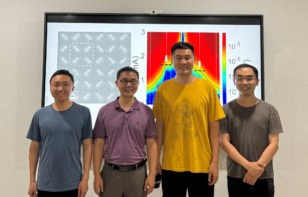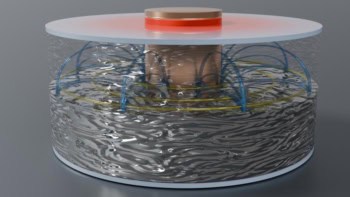
If a micron-sized sphere is coated half in gold and half in platinum, then placed in a solution of hydrogen peroxide, it will start to “swim” with its gold side pointing forwards. Dubbed “Janus spheres” for the two-faced Roman god, the motions of these self-propelling particles have long captivated physicists. Now, a team of UK researchers led by Daan Frenkel at the University of Cambridge has shown that their movements can be largely explained by momentum boosts imparted on them by chemical reactions taking place on their platinum sides.
Key to the motion of a Janus sphere is the asymmetry of the chemical activity that occurs at its surface. While gold is unreactive, platinum acts as a catalyst that significantly hastens chemical reactions. Hydrogen peroxide in contact with platinum will decompose into hydrogen and oxygen, releasing energy in the process. In 2012, researchers in the US showed that this reaction produces bubbles on the platinum surface that initially grow, then burst suddenly. While the bursting does contribute to the propulsion of a Janus sphere, it cannot fully explain the motion.
Rocket fuel
In their study, Frenkel’s team re-visited the problem after discussing how hydrogen peroxide is a common ingredient in rocket fuel and contributes significantly to a rocket’s propulsion through its decomposition. For this to occur with a Janus sphere, chemical reactions near the platinum surface should transfer momentum to the sphere. The concept was relatively simple, but had nonetheless gone largely unexplored in previous studies.

Bursting bubbles drive micromotors
To test the idea, Frenkel and colleagues created a computer simulation of a Janus sphere, in which each decomposition of a hydrogen peroxide molecule on its platinum side imparted a small amount of momentum to the sphere. When they accounted for the fluid properties of the solution, Frenkel and colleagues found that the resulting speed of their virtual sphere showed a clear relationship with the energy released during these reactions.
The team says its results agree reasonably well with observations from real experiments, and therefore provide the first clear evidence that chemical reactions must be considered as an important Janus sphere propulsion mechanism, along with bubbles. The team now plans to study Janus particles with non-spherical shapes and also look at spheres with more complex surface patterns of catalysts. Their research could lead to new types of micro- and nanoscale motors, as well as provide new insights into biological process such as the self-propulsion of living cells.
The research is described in Physical Review Letters.



